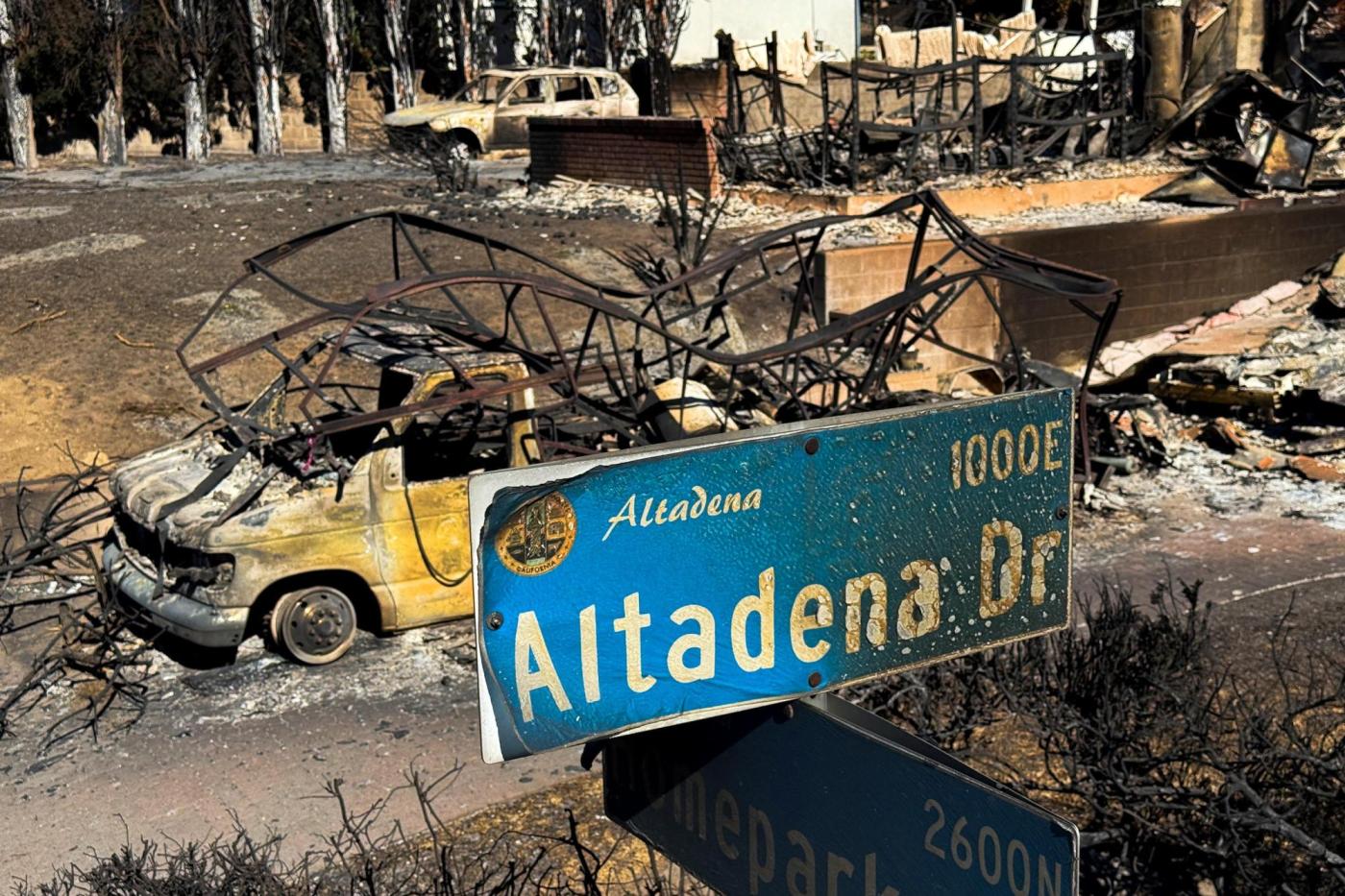
By Levi Sumagaysay, CalMatters
Remains of a house severely damaged by the Eaton Fire in the Altadena. Jan. 20, 2025. Photo by Jules Hotz for CalMatters
State Farm can raise homeowner and other rates starting next month, becoming the first insurance company to win approval to do so on an emergency interim basis in California.
The state’s largest insurer made the unprecedented request for emergency rate hikes earlier this year, after it said it was in financial distress and expected more than $7 billion in claims because of the Los Angeles County fires in January.
The state Insurance Department staff recommended approval of the company’s request, but Insurance Commissioner Ricardo Lara asked the company for more information about its finances. He also asked whether the insurer could turn to its parent company, State Farm Mutual, for help. Lara then conditionally approved but punted the official decision to a judge, who oversaw a three-day public hearing last month to consider the proposed agreement between the department and the insurer.
“Taken as a whole, it represents a fundamentally fair, adequate, and necessary measure — effectively functioning as a rescue mission to stabilize State Farm’s financial condition while safeguarding policyholders,” wrote Karl-Fredric Seligman, the administrative law judge, in a 38-page decision released today.
Lara, who as commissioner has the last word, adopted the ruling today. The decision means State Farm can raise its rates an average 17% for homeowners, 15% for renters and condominiums and 38% for rental dwellings starting June 1.
“I am balancing all the facts,” Lara said in a statement. “Protecting all State Farm customers and the integrity of our insurance market is an urgent matter.” He added that the company must still justify its need for rate increases at a full rate hearing late this year.
“Today’s decision that would make consumers pay now but allow State Farm to wait months before having to show its math is a great disappointment for consumers,” said Carmen Balber, executive director of Consumer Watchdog, the advocacy group whose lawyers had argued against approval of the rate hike at the hearing, in a statement. “Voter-approved Proposition 103 says a rate hike shouldn’t come before the rate justification, but that’s what happened here,” Balber added.
The approval comes despite calls for the insurance department to investigate complaints over State Farm’s handling of claims by victims of the LA-area fires. Those survivors and the lawmakers that represent them say the company has delayed and denied claims, and urged Lara to reject the company’s request to raise its rates. But the commissioner told fire survivors in a Zoom meeting over the weekend that the rate hike and the claims complaints were separate matters.
“That’s exactly the problem,” said Joy Chen, leader of the Eaton Fire Survivors Network. “Approving this rate hike without reviewing State Farm’s conduct would send a chilling message to every Californian: You can pay your premiums — but don’t count on your insurer when disaster strikes.”
State Farm spokesperson Sevag Sarkissian said “we have the largest claims force in the industry, and they are focused on our customers and helping them recover from the largest fire event we have ever experienced in the state.”
Lara wrote a letter to State Farm Chief Executive Dan Krause last week, asking for details about the company’s handling of claims. In Krause’s response, he wrote that the company has received complaints on less than 3% of the more than 10,000 claims filed after the LA-area fires.
The CEO also said in the letter that the company would provide information requested by Lara’s department on the standards it uses to review, investigate and process smoke damage claims.
But Krause declined to increase the amount of contents coverage it provides to policyholders without requiring an inventory to 75% as requested by Lara, saying the 65% it provides already leads the industry.
In his statement today, Lara said he expects the company to pay its claims to fire survivors “fully and fairly,” and implied his department could conduct a more formal investigation into the complaints. “Nothing is off the table,” the commissioner said.
In the judge’s decision about the rate increase, he addressed the possibility that this first-of-its-kind approval could pave the way for other insurance companies to request emergency interim rate increases after other major fires. Seligman also mentioned that State Farm still will be required to further prove its case for the original rate-increase requests it submitted last year, which will be considered in a full rate hearing. That hearing had been scheduled for next month but now may not begin until October so the parties can prepare for it.
“A full rate hearing serves as a critical signal to the marketplace that emergency rate requests of the type State Farm advanced are serious (and) will undergo rigorous scrutiny,” the judge wrote.
State Farm has promised to provide refunds to policyholders if after the full rate hearing the approved rates are lower than the interim rates. As a condition of being granted the interim rate increases, State Farm agreed to obtain a $400 million surplus note from its parent company, and promised to cease non-renewals of policies through the end of the year.
State Farm wrote in its post-hearing brief that approval of its rate request was vital for its financial strength. The insurer said its financial position has led to a couple of credit downgrades and it was trying to avoid any additional downgrades, which could endanger the insurance policies of more than 1 million California homeowners.
Granting State Farm the rate increases was in the best interest of the state’s consumers because it helps keep insurance available, the Insurance Department’s post-hearing brief read.
Consumer Watchdog, the advocacy group that had objected to the interim rate hikes, wrote in its post-hearing brief that State Farm failed to prove that the increases were actuarially justified.
This article was originally published on CalMatters and was republished under the Creative Commons Attribution-NonCommercial-NoDerivatives license.